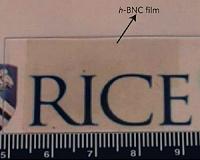 |
Philadelphia PA (SPX) Mar 01, 2010 Researchers at the University of Pennsylvania, the University of Wisconsin-Madison and IBM Research-Zurich have fabricated an ultra sharp, diamond-like carbon tip possessing such high strength that it is 3,000 times more wear-resistant at the nanoscale than silicon. The end result is a diamond-like carbon material mass-produced at the nanoscale that doesn't wear. The new nano-sized tip, researchers say, wears away at the rate of one atom per micrometer of sliding on a substrate of silicon dioxide, much lower than that for a silicon oxide tip which represents the current state-of-the-art. Consisting of carbon, hydrogen, silicon and oxygen molded into the shape of a nano-sized tip and integrated on the end of a silicon microcantilever for use in atomic force microscopy, the material has technological implications for atomic imaging, probe-based data storage and as emerging applications such as nanolithography, nanometrology and nanomanufacturing. The importance of the discovery lies not just in its size and resistance to wear but also in the hard substrate against which it was shown to perform well when in sliding contact: silicon dioxide. Because silicon -- used in almost all integrated circuit devices -- oxidizes in atmosphere forming a thin layer of its oxide, this system is the most relevant for nanolithography, nanometrology and nanomanufacturing applications. Probe-based technologies are expected to play a dominant role in many such technologies; however, poor wear performance of many materials when slid against silicon oxide, including silicon oxide itself, has severely limited usefulness to the laboratory. Researchers built the material from the ground up, rather than coating a nanoscale tip with wear-resistant materials. The collaboration used a molding technique to fabricate monolithic tips on standard silicon microcantilevers. A bulk processing technique that has the potential to scale up for commercial manufacturing is available. Robert Carpick, professor in the Department of Mechanical Engineering and Applied Mechanics at Penn, and his research group had previously shown that carbon-based thin films, including diamond-like carbon, had low friction and wear at the nanoscale; however, it has been difficult to fabricate nanoscale structures made out of diamond-like carbon until now. Understanding friction and wear at the nanoscale is important for many applications that involve nanoscale components sliding on a surface. "It is not clear that materials that are wear-resistant at the macroscale exhibit the same property at the nanoscale," lead author Harish Bhaskaran, who was a postdoctoral research at IBM during the study, said. Defects, cracks and other phenomena that influence material strength and wear at macroscopic scales are less important at the nanoscale, which is why nanowires can, for example, show higher strengths than bulk samples. The study, published in the current edition of the journal Nature Nanotechnology, was conducted collaboratively by Carpick and postdoctoral researcher Papot Jaroenapibal of the Department of Mechanical Engineering and Applied Mechanics in Penn's School of Engineering and Applied Science; Bhaskaran, Bernd Gotsmann, Abu Sebastian, Ute Drechsler, Mark A. Lantz and Michel Despont of IBM Research-Zurich; and Yun Chen and Kumar Sridharan of the University of Wisconsin. Jaroenapibal currently works at Khon Kaen University in Thailand, and Bhaskaran currently works at Yale University.
Share This Article With Planet Earth
Related Links University of Pennsylvania Space Technology News - Applications and Research
 Rice Researchers Make Graphene Hybrid
Rice Researchers Make Graphene HybridWashington DC (SPX) Mar 03, 2010 Rice University researchers have found a way to stitch graphene and hexagonal boron nitride (h-BN) into a two-dimensional quilt that offers new paths of exploration for materials scientists. The technique has implications for application of graphene materials in microelectronics that scale well below the limitations of silicon determined by Moore's Law. New research from the lab of P ... read more |
|
| The content herein, unless otherwise known to be public domain, are Copyright 1995-2010 - SpaceDaily. AFP and UPI Wire Stories are copyright Agence France-Presse and United Press International. ESA Portal Reports are copyright European Space Agency. All NASA sourced material is public domain. Additional copyrights may apply in whole or part to other bona fide parties. Advertising does not imply endorsement,agreement or approval of any opinions, statements or information provided by SpaceDaily on any Web page published or hosted by SpaceDaily. Privacy Statement |